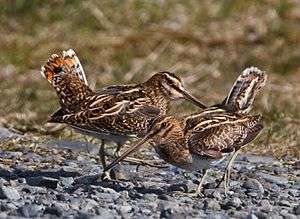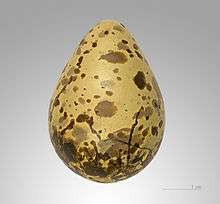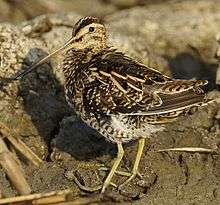Common snipe
| Common snipe | |
|---|---|
| | |
| Scientific classification | |
| Kingdom: | Animalia |
| Phylum: | Chordata |
| Class: | Aves |
| Order: | Charadriiformes |
| Suborder: | Scolopaci |
| Family: | Scolopacidae |
| Genus: | Gallinago |
| Species: | G. gallinago |
| Binomial name | |
| Gallinago gallinago (Linnaeus, 1758) | |
| Subspecies | |
|
G. g. faroeensis | |
| Synonyms | |
|
Capella gallinago | |
The common snipe (Gallinago gallinago) is a small, stocky wader native to the Old World. The scientific name gallinago is New Latin for a woodcock or snipe from Latin gallina, "hen" and the suffix -ago, "resembling".[2]
The breeding habitat is marshes, bogs, tundra and wet meadows throughout northern Europe and northern Asia. It is migratory, with European birds wintering in southern and western Europe and Africa (south to the Equator), and Asian migrants moving to tropical southern Asia. The North American Wilson's snipe was previously considered the same species, and is listed as such in older field guides.
Description


Adults are 25–27 cm (9.8–10.6 in) in length with a 44–47 cm (17–19 in) wingspan and a weight of 80–140 g (2.8–4.9 oz) (up to 180 g (6.3 oz) pre-migration). They have short greenish-grey legs and a very long (5.5–7 cm (2.2–2.8 in)) straight dark bill. The body is mottled brown with straw-yellow stripes on top and pale underneath. They have a dark stripe through the eye, with light stripes above and below it. The wings are pointed.[3][4]
It is the most widespread of several similar snipes. It most closely resembles the Wilson's snipe (G. delicata) of North America, which was until recently considered to be a subspecies — G. g. delicata — of common snipe. They differ in the number of tail feathers, with seven pairs in G. gallinago and eight pairs in G. delicata; the North American species also has a slightly thinner white trailing edge to the wings (the white is mostly on the tips of the secondaries).[5][6] Both species breed in the Aleutian Islands.[3] It is also very similar to the pin-tailed snipe (G. stenura) and Swinhoe's snipe (G. megala) of eastern Asia; identification of these species there is complex.[7]
There are two subspecies of common snipe, G. g. faeroeensis in Iceland, the Faroes, Shetland and Orkney (wintering in Britain and Ireland), and G. g. gallinago in the rest of the Old World.
Ecology
_at_Bharatpur_I_IMG_5750.jpg)
It is a well camouflaged bird, it is usually shy and conceals itself close to ground vegetation and flushes only when approached closely. When flushed, they utter a sharp note that sounds like scape, scape and fly off in a series of aerial zig-zags to confuse predators.[8] They forage in soft mud, probing or picking up food by sight. They mainly eat insects and earthworms, also some plant material.[4]
 |
Common snipe
An example of the "drumming" sound. |
| Problems playing this file? See media help. | |
The male performs "winnowing" display during courtship, flying high in circles and then taking shallow dives to produce a "drumming" sound by vibrating its tail feathers. This sound has been compared by others to the bleating of a sheep or goat; hence in many languages the snipe is known by names signifying “flying goat,” “heaven's ram,” as in Scotland by “heather-bleater”[8] and in Finnish the name taivaanvuohi, "sky goat".
Philip Manson-Bahr is credited with unravelling the mystery of how the shrike creates that unusual breathy sound which is unlike other birdsong. He worked out that the sound was created by placing out two tail feathers at 90 degrees to the direction of flight. When diving these feathers create this unusual sound. He demonstrated this in front of the British Ornithologists Union by inserting two shrike feathers into a cork which he then whirled around his head on a string.[9]
Common snipe nest in a well-hidden location on the ground, laying four eggs of a dark olive colour, blotched and spotted with rich brown,[8] which are incubated by the female for 18–21 days. The freshly hatched young are covered in dark maroon down, variegated with black, white and buff.[8] The young are cared for by both parents, each parent looking after half the brood, with fledging in 10–20 days.[3][4]
Conservation

Overall, the species is not threatened. Populations on the southern fringes of the breeding range in Europe are however declining with local extinction in some areas (notably in parts of England and Germany), mainly due to field drainage and agricultural intensification.[3]
The Agreement on the Conservation of African-Eurasian Migratory Waterbirds (AEWA) applies to the species. It is still hunted as a gamebird in much of its range.[3]
History
Old folk names include "mire snipe", "horse gowk", "heather bleat", and the variant spelling "snite".[10] See snipe for other aspects of the name.
References
- ↑ BirdLife International (2012). "Gallinago gallinago". IUCN Red List of Threatened Species. Version 2013.2. International Union for Conservation of Nature. Retrieved 26 November 2013.
- ↑ Jobling, James A (2010). The Helm Dictionary of Scientific Bird Names. London: Christopher Helm. p. 170. ISBN 978-1-4081-2501-4.
- 1 2 3 4 5 del Hoyo, Josep; Elliott, Andrew; Sargatal, Jordi, eds. (1996). Handbook of the Birds of the World. Volume 3: Hoatzin to Auks. Barcelona: Lynx Edicions. p. 496. ISBN 84-87334-20-2.
- 1 2 3 Snow, D.W.; Perrins, C.M. (1998). The Birds of the Western Palearctic. vol. 1 (Concise ed.). Oxford: Oxford University Press. ISBN 0-19-854099-X.
- ↑ Leader, P. (1999). "Identification forum: Common Snipe and Wilson's Snipe". Birding World. 12 (9): 371–374.
- ↑ Reid, M. (2008). "Identification of Wilson's and Common Snipe". British Birds. 101 (4): 189–200.
- ↑ Carey, G.; Olsson, U. (1995). "Field Identification of Common, Wilson's, Pintail and Swinhoe's Snipes". Birding World. 8 (5): 179–190.
- 1 2 3 4
 One or more of the preceding sentences incorporates text from a publication now in the public domain: Chisholm, Hugh, ed. (1911). "Snipe". Encyclopædia Britannica (11th ed.). Cambridge University Press.
One or more of the preceding sentences incorporates text from a publication now in the public domain: Chisholm, Hugh, ed. (1911). "Snipe". Encyclopædia Britannica (11th ed.). Cambridge University Press. - ↑ Cocker, Mark (2012-04-15). "Unfolding the mysteries of a snipe's lovesong". The Guardian. ISSN 0261-3077. Retrieved 2017-06-07.
- ↑ Lockwood, W.B. (1984). The Oxford Book of British Bird Names. Oxford University Press. ISBN 0-19-214155-4.
External links
| Wikimedia Commons has media related to Gallinago gallinago. |
| Wikispecies has information related to: Gallinago gallinago |
- "Common snipe media". Internet Bird Collection.
- Ageing and sexing (PDF; 5.1 MB) by Javier Blasco-Zumeta & Gerd-Michael Heinze
- "Gallinago gallinago". Avibase.

- Gallinago gallinago at Integrated Taxonomic Information System (ITIS)
- Items, photos and sounds related to Gallinago gallinago at Europeana: Europe's digital library, museum and archive
- BirdLife species factsheet for Gallinago gallinago
- Common snipe photo gallery at VIREO (Drexel University)
- Common snipe species account at NeotropicalBirds (Cornell University)
- Interactive range map of Gallinago gallinago at IUCN Red List maps
- Audio recordings of Common snipe on Xeno-canto.
